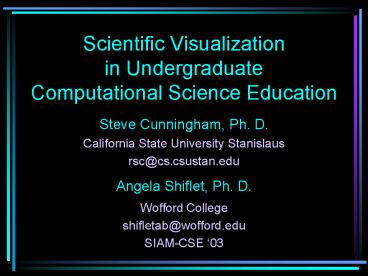Scientific Visualization in Undergraduate Computational Science Education - PowerPoint PPT Presentation
1 / 33
Title:
Scientific Visualization in Undergraduate Computational Science Education
Description:
Traditional computer graphics course. Technology of creating images. Scientific visualization ... Computer Graphics: Programming, Problem Solving, and Visual ... – PowerPoint PPT presentation
Number of Views:71
Avg rating:3.0/5.0
Title: Scientific Visualization in Undergraduate Computational Science Education
1
Scientific Visualization in Undergraduate
Computational Science Education
- Steve Cunningham, Ph. D.
- California State University Stanislaus
- rsc_at_cs.csustan.edu
- Angela Shiflet, Ph. D.
- Wofford College
- shifletab_at_wofford.edu
- SIAM-CSE 03
2
Outline
- Why scientific visualization in undergraduate CSE
- In modeling and simulation
- As separate course
- Experiences
3
Scientific Visualization -Integral Part of
Emerging Discipline
- 2002 Charles Swansons survey of undergraduate
computational science programs sponsored by Krell
Institute
4
Why scientific visualization in undergraduate CSE?
- Scientists toolkit
- Stimulates insight and understanding
- Presentations
- Fits well with modeling and simulation
5
Goal Introduce computer graphics into the
problem-solving cycle
6
Modeling and simulation
- Express results in graphical way
- Use tools, not sophisticated graphical techniques
- Matlab
- Mathematica or Maple
- Excel
- STELLA
- Tool addresses specific kind of problem best
7
Mathematica -graphical computer algebra system
- Example - cellular automata simulation of spread
of fire in forest
8
Mathematica for simulations
- Program to
- Perform simulation
- Generate image for each time step
- Animate results
- Alter parameters to investigate
- Example - probability of lightening
9
STELLA tool models dynamic systems
- Example - predator-prey populations
- Diagram of model
10
Modeling predator-prey populations
11
Graphics to depict results of time-driven
simulations
12
Tool only presents part of set of images to
represent given problem
- Tool influences process of understanding results
- encouraging one way
- limiting other ways of thinking about a problem
13
CSE program should include computer graphics
course
- Fundamentals, not packages
- Graphics tools change quickly
- Leading-edge researchers often write or revise
specially tailored programs - Lawrence Livermore National Laboratory
- Scripps Laboratory
14
Focus
- Traditional computer graphics course
- Technology of creating images
- Scientific visualization
- Fundamental graphics concepts
- Algorithms
- Developing programs to create effective images
for scientific applications
15
Fundamental concepts for Scientific
Visualization
- Graphics pipeline
- Modeling
- Transformations
- Color, Lighting, Shading
- Interaction
- Visual communication for sciences
- Programming with graphics API, such as OpenGL
16
(No Transcript)
17
Emphasis in Computational Science at Wofford
College
- BS in
- Biology
- Chemistry
- Mathematics
- Physics
- Psychology
- 5 courses
- Summer internship
18
ECS courses
- C Programming
- Data Structures
- Calculus I
- Scientific Programming
- Data and Visualization
19
Scientific Programming -Modeling and Simulation
- STELLA, C, Mathematica
- Applications
- Predator-prey model
- Radioactive Chains
- Enzyme Kinetics
- Spread of Influenza
- Spread of Fire
- Animal Foraging
20
Interactive Textbookwww.wofford.edu/ecs/
21
Data and Visualization
- Developing Web-Accessed Databases
- Algorithms
- Genomic Sequence Comparison
- Searching Genomic Databases
- Programming Scientific Visualizations
22
Text
- Computer Graphics Programming, Problem Solving,
and Visual Communication - Steve Cunninghams materials
- www.cs.csustan.edu/rsc/NSF
23
Scientific applications - Examples and
Assignments
24
Diffusion of heat through a metal bar
25
Program template - initialization
26
Program template - reshape, display, idle
27
Program Template - main
barchart
barchart.c
28
Spread of Malaria
29
Gas laws
30
Lorenz Equations
31
Interactive display of molecule from molecule
description file
32
Why scientific visualization now possible in
undergraduate CSE?
- Today, need
- Personal computers
- Readily available compilers
33
National Science Foundation
- This material is based upon work supported by the
National Science Foundation under Grants
DUE-9950121 and DUE-0087979































